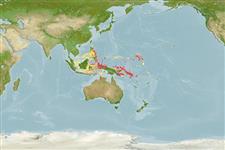Classification / Names
ชื่อสามัญ | ชื่อพ้อง | Catalog of Fishes(สกุล, ชนิด) | ITIS | CoL | WoRMS | Cloffa
>
Acanthuriformes (Surgeonfishes) >
Pomacanthidae (Angelfishes)
Etymology: Chaetodontoplus: Greek, chaite = hair + Greek, odous = teeth + Greek, plous, ous, oo = crossing (Ref. 45335); poliourus: Named for its grey caudal fin..
More on authors: Randall & Rocha.
Environment: milieu / climate zone / depth range / distribution range
นิเวศวิทยา
เกี่ยวกับทะเล,น้ำเค็ม เกี่ยวกับหินโสโครก; ระดับความลึก 1 - 20 m (Ref. 90102). Tropical
การแพร่กระจาย
ประเทศต่างๆ | พื้นที่จำแนกตาม FAO | ระบบนิเวศหลายระบบ | การปรากฏขึ้น,การเกิดขึ้น,พบ | Point map | การแนะนำ | Faunafri
Western Pacific: Papua New Guinea, Solomon Islands, Palau and Indonesia.
ขนาด / น้ำหนัก / Age
Maturity: Lm ? range ? - ? cm
Max length : 8.6 cm SL เพศผู้/กระเทย; (Ref. )
Short description
สัณฐานวิทยา | ความยาวต่างๆ
เงี่ยงครีบหลัง (รวม): 12; ก้านครีบอ่อนที่หาง (รวม): 17; เงี่ยงครีบก้น 3; ก้านครีบอ่อนที่ก้น: 16 - 17; สัตว์มีกระดูกสันหลัง: 24. This species is distinguished by the following characters: D XII,17 (rarely 16or 18); A III,16 or 17; pectoral rays 15-17 (usually 16); small scales, about 80 in longitudinal series; dorsal series of pored lateral line scales 29-35; gill rakers 4 + 12; supraneural bones 2; body depth 1.70-1.85 in SL; head length 3.15-3.3 in SL; fourth to sixth dorsal spines longest, 1.1-1.3 in HL. Preserved color head and anterior body pale yellowish grey to an approximate oblique demarcation connecting base of second to third dorsal spine to anus, gradually changing posteriorly in an intermediate zone containing pectoral fin to one of irregular longitudinal lines on dark brown; a dark brown bar from nape, broadening as it passes through eye, then curving and narrowing as it ends shortly before origin of pelvic fins; front of lips brown; dorsal and anal fins colored as adjacent body; caudal fin abruptly pale grey; paired fins pale yellowish. Color in life: dark brown posteriorly with white dots, which merge anteriorly to form narrow irregular white lines; dark brown of body progressively lighter anteriorly, becoming pale grey at demarcation, then gradually changing to pale yellow on head; ocular bar black, narrowly edged in bluish white; snout and chest yellow, the front lips blue which sometimes continue as a narrow triangle medially in front of snout; first 3-4 dorsal spines and membranes yellow, the rest of fin dark brown with rows of white dots paralleling rays on about basal 3/4 of fin; narrow white or blue margin on soft part of fin; anal fin similar, but not yellow anteriorly; caudal fin grey with a narrow yellow posterior border; pectoral fins pale grey; pelvic fins bright yellow (Ref. 82330).
Very close to Chaetodontoplus mesoleucus (Bloch, 1787) with different colors on pelvic, dorsal and caudal fins. The two species coexist in several islands of Indonesia (Ref. 82330). These islands include Lesser Sunda Islands. Molucca Islands, Halmahera, and Bird's Nest Peninsula of West Papua (Ref. 90102).
Life cycle and mating behavior
วัยเจริญพันธุ์ | การสืบพันธุ์ | การวางไข่ | เซลสืบพันธ์ของเพศเมีย(ไข่) | ความดกของไข่ | ตัวอ่อน
Randall, J.E. and L.A. Rocha, 2009. Chaetodontoplus poliourus, a new angelfish (Perciformes: Pomacanthidae) from the Tropical Western Pacific. The Raffles Bull. Zool. 57(2):511-520. (Ref. 82330)
IUCN Red List Status (Ref. 130435)
Threat to humans
Harmless
Human uses
ข้อมูลเพิ่มเติม
ประเทศต่างๆพื้นที่จำแนกตาม FAOระบบนิเวศหลายระบบการปรากฏขึ้น,การเกิดขึ้น,พบการแนะนำStocksนิเวศวิทยาอาหาร, โภชนาการรายการอาหารการบริโภคอาหารอาหารสำหรับสัตว์น้ำแต่ละตัว
ชื่อสามัญชื่อพ้องกลไกการเผาผลาญพลังงานผู้ล่าการศึกษาเกี่ยวกับผลกระทบของสารประกอบทางเคมีที่เป็นอันตรายต่อสิ่งมีชีวิต ประชากร และสิ่งแวดล้อมการสืบพันธุ์วัยเจริญพันธุ์การวางไข่การรวมกลุ่มวางไข่ความดกของไข่เซลสืบพันธ์ของเพศเมีย(ไข่)Egg development
Age/SizeการเจริญเติบโตLength-weightLength-lengthLength-frequenciesความยาวต่างๆสัณฐานวิทยาตัวอ่อนพลวัตของสัตว์น้ำวัยอ่อนการทดแทนที่อุดมสมบรูณ์BRUVS
อ้างอิงการเพาะเลี้ยงสัตว์น้ำประวัติการเพาะเลี้ยงสัตว์น้ำสายพันธุ์พันธุศาสตร์ElectrophoresesอัตราพันธุกรรมโรคการแปรรูปNutrientsMass conversion
ผู้ร่วมมือรูปภาพหลายรูปStamps, Coins Misc.เสียงปลามีพิษ เช่น ปลาปักเป้าความเร็วรูปแบบการว่ายน้ำพื้นที่เหงือกOtolithsสมองวิสัยทัศน์
เครื่องมือ
Special reports
Download XML
แหล่งที่มาจากอินเตอร์เน็ต
Estimates based on models
Preferred temperature (Ref.
123201): 28.8 - 29.3, mean 29 °C (based on 385 cells).
Phylogenetic diversity index (Ref.
82804): PD
50 = 0.5000 [Uniqueness, from 0.5 = low to 2.0 = high].
Bayesian length-weight: a=0.03090 (0.01359 - 0.07026), b=2.89 (2.70 - 3.08), in cm total length, based on LWR estimates for this (Sub)family-body shape (Ref.
93245).
Fishing Vulnerability (Ref.
59153): Low vulnerability (10 of 100).
